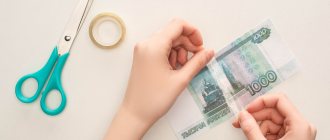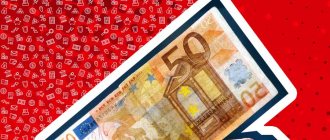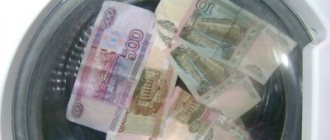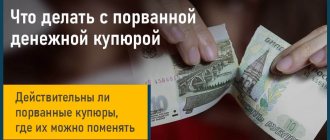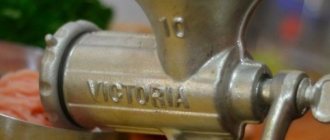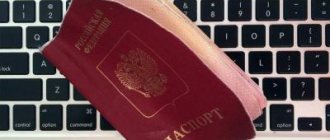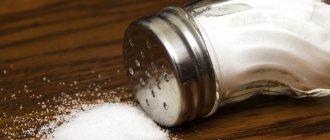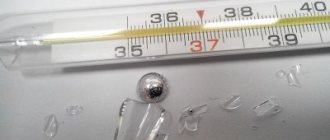We placed the card in the card reader, entered the PIN code, put the money in the bill acceptor, the ATM swallowed the money, and there was silence on the account. One of the most frequently encountered cases in the “People's Rating” of Banki.ru. What to do?
Despite the fact that customers often complain about the problem, the share of unsuccessful transactions in their total number is small. At least that's what bankers say. Thus, according to Tinkoff Bank, less than 0.00001% of deposits fail.
The procedure for depositing money into an account can be divided into four stages. The reasons for failures on each of them are different:
- The client deposits money into the ATM. Most often, according to Gleb Zelenin, head of the MKB payment services department, the problem arises here. Crinkled, torn, painted banknotes, paper clips, rubber bands and tape can be used. Tinkoff Bank adds to this list incorrectly counted bills before depositing, errors in entering the recipient’s details, and confusion in cards. In general, the main source of problems with depositing money into an account through an ATM, according to banks, is the human factor, or more precisely, the client himself.
- The ATM counts the money and places it in the safe. Theoretically, the mechanism can jam, but this rarely happens. If the bills are in order, the hardware will almost certainly handle them.
- The ATM sends a signal about crediting funds to the client's card. This is a problematic stage, but modern ATMs, according to Zelenin, do not need to be connected to accept money. They will process the transaction and transmit the information to the bank as soon as communication with the server is restored.
- Processing itself, entering information into databases. It usually goes without a hitch.
How to deal with a torn banknote
Torn or stained banknotes can be exchanged at any bank branch if we are talking about Russian rubles and not foreign currency. It is not necessary to contact the office of a large institution; you can come to a small branch of any bank.
To exchange a damaged banknote for a new one, go to the cashier with your passport. In some cases, you will be asked to fill out an application, but if the damage is minor and the authenticity is beyond doubt, the bill will be exchanged for another without this. If doubts about the authenticity arise, then another bill will be issued after an examination or money will be credited to your account if it is open at this bank.
A banknote can be damaged in different ways. The cashier's actions depend on how bad the money is. The banknote will be replaced without any problems if more than half of its parts are in your possession.
Tears on the banknote
Banknotes with tears can often be found. They are issued with change in stores, so it is easy to miss. Most often, tears occur on small bills that are in constant circulation. Money of larger denominations does not wear out as much. One-hundred-ruble bills are withdrawn from circulation every year, but five-thousand-ruble bills may not lose their appearance even after 5 years.
Banknotes with tears can be used to pay in other stores or at the market, but ATMs and payment terminals will not accept such banknotes. If you need to transfer money to a bank account, but do not have another banknote with you, contact the bank cashier; he will not make claims for torn money. If the tear is large enough, the banknote can be glued with tape; such money is usually accepted for payments in all stores.
Corner of banknote torn off
If the part of the bill that contains the serial number is torn off, it may not even be considered damage. But if about a third of the bill is missing, the store is unlikely to accept it. It’s better to immediately go to the bank’s cash desk and exchange the damaged one for a whole one. Banknotes with a clearly visible serial number will be accepted immediately. If any part of the serial number is missing or is difficult to see, an examination will be carried out first.
If a little more or about half of the bill has been preserved, it will not be possible to exchange it even at the bank’s cash desk. The rules are set to protect against scammers. Anyone can deliberately tear a banknote and go to a bank cashier with the expectation of receiving two banknotes instead of one. Such bills will not be exchanged at the cash register, and may even be subject to criminal liability if deliberate deception is revealed.
It is better not to take risks and not to carry banknotes smaller than 55% of the original size. But if you give the cashier two halves of bills with different serial numbers, they will be exchanged for one whole banknote.
Banknote torn in half
If you yourself accidentally tore a bill and both parts remain, do not be upset. This money is not lost, it can definitely be exchanged at the cash register. You can even carefully glue the banknote with tape and pay with it in any store. But it’s better to immediately take the bill to the bank to get whole money in return.
If you decide to take a banknote torn in half to the bank, you don’t have to glue it together, but simply present the two halves. After the cashier is convinced that the torn parts belong to the same banknote, they will immediately issue a new one.
Banknote torn into several pieces
You can exchange a banknote torn into many pieces at a bank only under certain conditions. You must have at least 55% of the whole bill. Torn parts can be glued with tape.
The bank will accept the bill if you can prove that the torn parts belong to the same bill and have the same serial number. If the identity of one banknote is doubtful, you will have to write a statement and wait for an examination. You may be prosecuted for attempted fraud.
Torn foreign banknote
It is impossible to pay in stores with a torn foreign banknote or to top up a bank account with it. The only way out is to bring it to the bank cash desk. But there is no guarantee that the bill will be exchanged for a whole one.
The fact is that the exchange of damaged foreign banknotes is not regulated by the law of the Russian Federation. It applies only to Russian rubles. Therefore, each bank can set its own rules for exchanging torn money. In some places you may be lucky and the bill will be exchanged, but in others they will refuse. And even if the bank employees agree to exchange the money, you will most likely be charged an additional commission for exchanging the damaged banknote.
Some Russians use a different scheme: they give damaged foreign banknotes to those who travel abroad. In a country where the currency is considered national, damaged money can be easily exchanged at any bank and no payment will be charged for it. No one can oblige Russian banks to accept torn banknotes from foreign countries free of charge.
The nuances of exchanging damaged dollars and euros
Regarding the exchange of damaged currencies, the Central Bank did not issue any resolutions or instructions. Accordingly, the exchange process is regulated exclusively by the bank where the applicant applied. The bank may refuse to exchange the banknote if it appears to be significantly damaged. In addition, many Russian banks simply do not offer services specifically for exchanging a torn foreign banknote for a whole one.
Therefore, a bank employee can offer several options:
- Replace foreign currency with Russian rubles;
- Credit money to your current or deposit account after converting currencies in accordance with the current exchange rate;
- The so-called "collection". Money for collection is sent to the country where the banknote was issued. The process can take years, and you still have to pay a fee for using the service.
Please note that all transactions are carried out with a commission - usually 3-12% of the face value of the foreign currency. If the bill is severely damaged, the bank may impose an increased commission or refuse service altogether.
When is expertise needed when exchanging currencies?
Examination of a banknote is a check of authenticity. The service is provided at bank cash desks. If the cashier has doubts that the bill is real, he will conduct an examination free of charge. This way, bank employees can make sure that they are not dealing with a fraudster.
Without examination they exchange:
- Banknotes torn in half and glued together with tape. Provided that the parts belong to the same banknote with the same serial number.
- Torn banknotes. The number and size of damage does not matter.
- Banknotes with torn or stained edges. But the area of the lost parts should not be too large. The surviving banknote must contain a serial number.
- Punctured bills. The punctures should not be too large. If they are large, they should not be located in the place of the serial number or denomination of the banknote.
- Banknotes with minor abrasions and dirt. Even the part containing the serial number may be contaminated. But some of the signs must remain distinguishable.
You can exchange not only paper banknotes, but also coins at bank cash desks. They can be bent or modified, but must retain the design on both sides.
Does the store have the right to refuse to accept such a bill?
This happens quite often. Sometimes citizens receive banknotes that are so old or damaged that no store accepts them. What’s most interesting is that it’s usually small retail outlets that try to push damaged money away to customers upon delivery. So this kind of exchange of damaged bills takes place, they go around in a circle.
Only the law obliges stores to accept such money. There is an instruction from the Central Bank of the Russian Federation, which indicates which banknotes are valid and solvent, despite the presence of damage.
We are talking about the following types of damage:
- torn, with missing corners and edges (it is clear that this means that the damage did not affect the readability of the number, the loss of an edge is no more than a third);
- dirty, with extraneous inscriptions, with seal imprints;
- torn, pierced.
The seller has no right to refuse to accept a banknote with such damage. But the buyer can refuse to accept it as change.
So, in fact, the replacement of a damaged banknote can go through the store if the damages are those prescribed by the Central Bank. And it’s better to go with that kind of money to a large chain store, they won’t refuse to accept you. In the future, organizations themselves hand over the damaged banknotes to banks, exchanging them for normal ones.
What kind of money cannot be exchanged?
The bank may refuse to exchange a damaged banknote for several reasons:
- The banknote bears the inscription “Sample”. In this case, the inscription is printed on the banknote. If the word is written by hand, this will be considered damage or spoilage, but the bill can still be exchanged at the bank’s cash desk.
- The banknote is painted with a special paint, which is used to prevent theft from bank vaults.
- With any manufacturing defect.
- If the bill is old and has already gone out of circulation. These banknotes cannot be used to pay for purchases; they can only be kept as a souvenir.
- If 50% of the whole bill or even less is presented to the cashier...
The state constantly removes damaged banknotes from circulation. Dilapidated and torn money, although it retains signs of solvency, still becomes a problem not only for citizens, but also for banks. Credit institutions are reducing the volume of cash transactions and increasing the number of ATMs and terminals that do not accept torn banknotes. Therefore, all market participants are interested in removing such money from circulation.
Reasons for refusal
Frequent reasons for refusing to accept money from an ATM lie in the bill itself. It is too wrinkled, shabby, torn, written on or just new. Oddly enough, the ATM does not accept newly printed money.
Other reasons for refusal:
- The tray with this denomination of banknotes in the ATM is full. The solution to the problem is to change the bill.
- The bill is crumpled and the ATM cannot grab it. The solution is to smooth out the bill with your hands or use another one.
- The wrong service has been selected at the ATM, which does not accept cash.
- The money is clean and not wrinkled, but the ATM refuses to accept it. The bill acceptor may be clogged or faulty. The solution is to use another machine or go to a bank branch.
What to do if the bank refuses to change the banknote
If the bank refuses to exchange your torn bill for a whole one, use one of two options.
- Contact the cash desk of another bank.
- If the bank employee does not want to carry out the exchange, ask for written confirmation of the refusal.
If the cashier refuses to issue a written confirmation, file a claim with the bank yourself. Ask to explain the reasons for the refusal to exchange the banknote. The bank will definitely respond to the complaint. Wait for it and send it along with a copy of the claim to the Bank of Russia. A letter from the Central Bank of the Russian Federation will be sent in response to your request.
According to the Directive of the Bank of Russia No. 1778 of December 26, 2006, cashiers cannot refuse to exchange national currency if the provided banknotes comply with the terms of exchange and do not contain signs of counterfeiting.
How long does the investigation take?
Most complaints can be resolved by watching videos from an ATM, they say at Tinkoff Bank. Sometimes the money can be returned on the same day, usually within three to four days.
If the results of such an investigation are not sufficient to make a decision on the claim or the client claims that he deposited a larger amount, the bank waits for collection. Usually it occurs once a week, less often - once every two weeks . You cannot do without collection even if the ATM considers that the banknote deposited is counterfeit. You will have to set aside time for collection, handing over the banknote for examination, and waiting for the results.
MKB claims that funds are usually returned to clients within two weeks.
If a failure occurs today, and tomorrow the credit card’s grace period ends, the bank will begin to charge interest for using the loan and will do this until an investigation reveals an ATM error. If the bank admits that it was wrong, it must cancel the accrued interest, otherwise the client has the right to go to court.
What to do with damaged coins
Coins remain in circulation longer than banknotes. Metal money is more difficult to damage than paper money. They wear out longer and cannot be torn. If you still have damaged, dirty, or broken coins, you can deal with them as follows:
- If the shape of the coin has not changed, it is not bent, it has only minor abrasions and dirt, it can be used to pay in stores.
- Bent coins, sawn down, with drilled holes, which have lost no more than 25% of their mass, can be exchanged at the bank for whole ones.
- Melted coins that have changed color can also be exchanged at the cash desk, but only on the condition that their authenticity can be established.
The only coins that will not be accepted for exchange are those that completely lack a design or are broken into several pieces.
Give your rating
Let's sum it up
Thanks to updating the software of ATMs and the machines themselves, malfunctions are rare. However, old terminals and ATMs are still installed in corners remote from the capital. They are what cause most of the problems for users. Banknotes get jammed and the wrong amount is credited to the account. In all these cases, you should immediately call the technical service number indicated on the ATM or go to the bank with a statement of claim.
Two weeks ago I withdrew money from an ATM. I inserted the card, entered the PIN, and selected the amount. But then the lights turned off in the shopping center, and I found myself in complete darkness in front of a switched off ATM. I have a train in two hours, and the only card is in this piece of iron. I didn't know what to do.
Sergey Korol traveler
I decided to figure out how an ATM works and how it is protected from unforeseen circumstances. Thanks to Pavel Yudaev from Sea-Nord for consultations.
FAQ
Is it possible not to exchange a torn bill for a banknote of the same denomination, but to use it for payment at a bank?
Yes, you can use a damaged banknote for payment if an examination has proven that it is solvent and can be exchanged for an equivalent banknote.
Can I be refused to exchange a torn banknote if it is money from another country?
Yes, you may be refused both the exchange and acceptance of such a banknote, because banks are obliged to accept only solvent Russian rubles. There are no such requirements for foreign currencies.
If a banknote is torn into 3-4 pieces, can it be taken to the bank to be exchanged for a whole one?
Yes, you can exchange a banknote torn into several pieces if the bank teller makes sure that all the fragments belong to the same bill. Additional conditions are readability of the serial number and the total area of the fragments is at least 55% of the original size of the bill.
Do you need a passport when exchanging a torn banknote for a whole one?
If the cashier does not accept the application for examination, he can exchange the damaged banknote without a passport.
If a banknote is not torn, but burnt, can it be exchanged for new banknotes?
Yes, you can. The requirements are the same as for a torn banknote - at least 55% of the original size, readable serial number, and no signs of counterfeiting.
Sources:
- Directive of the Central Bank of December 26, 2006 No. 1778-U “On the signs of solvency and rules for the exchange of banknotes and coins of the Bank of Russia” (with amendments and additions)
- Federal Law No. 86 of July 10, 2002 “On the Central Bank of the Russian Federation (Bank of Russia)”
about the author
Klavdiya Treskova - higher education with qualification “Economist”, with specializations “Economics and Management” and “Computer Technologies” at PSU. She worked in a bank in positions from operator to acting. Head of the Department for servicing private and corporate clients. Every year she successfully passed certifications, education and training in banking services. Total work experience in the bank is more than 15 years. [email protected]
Is this article useful? Not really
Help us find out how much this article helped you. If something is missing or the information is not accurate, please report it below in the comments or write to us by email
Comments: 2
Your comment (question) If you have questions about this article, you can tell us. Our team consists of only experienced experts and specialists with specialized education. We will try to help you in this topic:
Author of the article: Klavdiya Treskova
Consultant, author Popovich Anna
Financial author Olga Pikhotskaya
- Natalia
10/01/2021 at 01:14 They refused to exchange 100 rubles that was torn in half. banknote, they asked for a commission of 100 rubles.
Reply ↓ Olga Pikhotskaya
10/01/2021 at 03:47Natalya, hello. If the bill was genuine, the bank teller had no right to refuse to exchange it and demand a commission. The commented article describes in detail the client’s procedure if the bank refuses to change the national banknote.
Reply ↓
Do I have to pay to replace a torn banknote?
If we are talking about replacing domestic currency, then the bank has no right to charge any interest for replacing money. The procedure is equal to other types of monetary transactions that are carried out free of charge. Accordingly, if a bank specialist demands that a visitor pay for replacing money, you need to immediately call the hall administrator and file a complaint.
Such rules apply to one banknote, which can be restored along the break line. The same applies to cases when only one part of the banknote is presented, and the second is lost. It must be accepted under the following conditions:
- if more than half of the bill is presented (more than 55%);
- when can you determine its dignity and number.
And if two fragments from different banknotes of the same denomination are provided, each of which has a size of at least 50%, then they will be accepted as one banknote. That is, for both fragments you can get only one bill of the same denomination.


